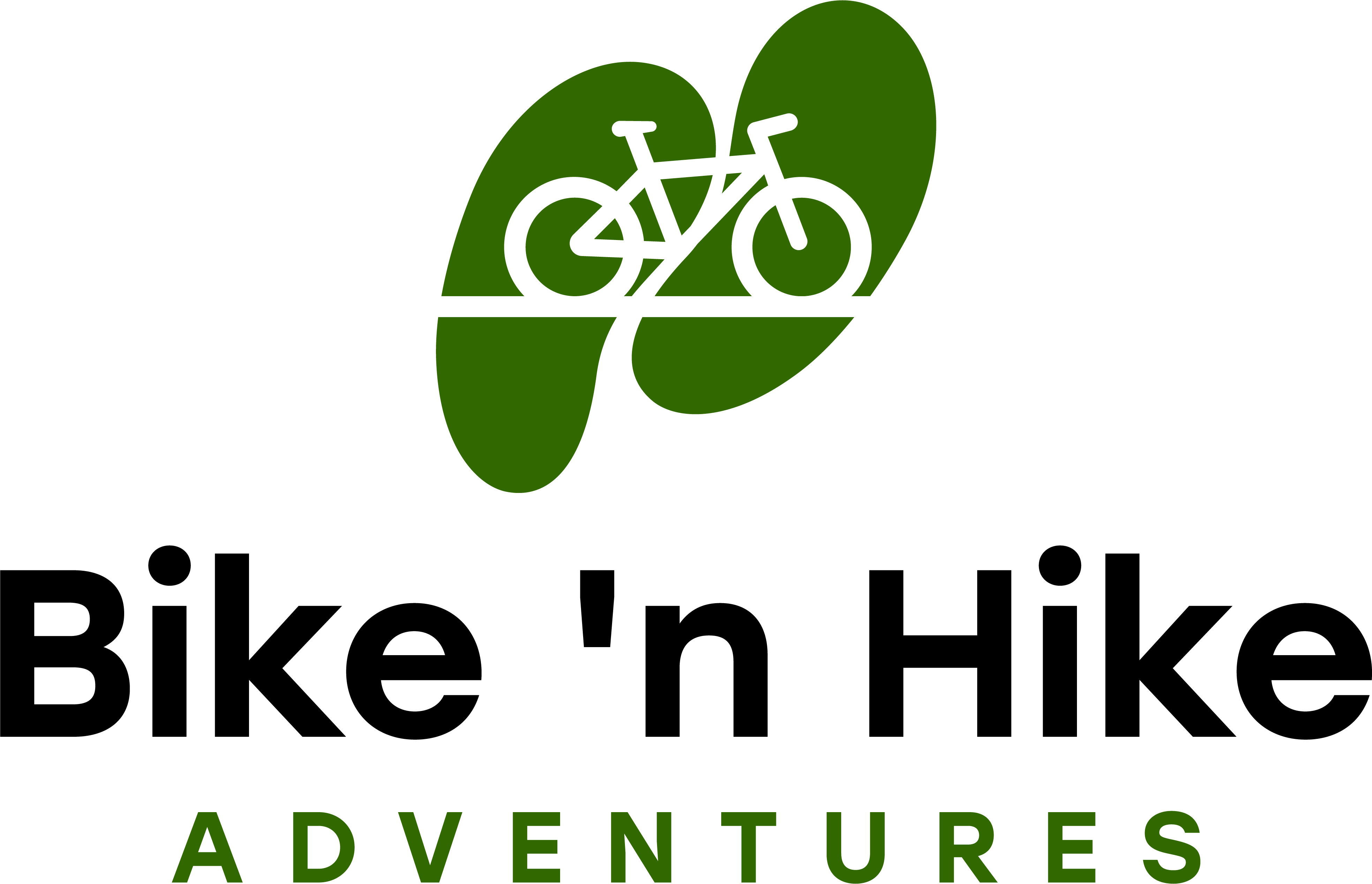Yukon Hiking 2024
I had the good fortune to return to Yukon to hike this year. I lived in Whitehorse for a year in 2020 and I was very excited to return to the land of the midnight sun to hike some of my favourite trails and try some new ones as well. I was travelling with one of my hiking clubs, 18 other keen hikers eager to experience the majestic beauty of the north.
Whitehorse
Our first morning included a tour of Whitehorse by bus, which served as a good reminder to me about where things were in the city and introduced me to some new things as well. We went to the fish ladder and learned that it is the longest wooden fish ladder in the world and plays a critical role in helping the salmon pass safely around the Whitehorse Rapids dam. We were too early in the season to see any fish passing through but the staff at the information centre were very knowledgeable and shared lots of information. This was closed in 2020 due to COVID so I am so glad I was able to stop in this time.
Back in the bus, we made our way to the SS Klondike sternwheeler (under restoration – no boat access), but stopped at the visitor welcome centre which was worth the time. We continued to Miles Canyon, one of my favourite places in Whitehorse. I was again astounded by its incredible beauty. We visited Canyon City, which I hadn’t done before, and learned of its importance during the gold rush days. We examined some of the remaining artifacts of the time and marvelled at the ability of people to quickly build a city with a dedicated tramway to address an acute need to support the stampeders (1897), a city which was pretty much deserted 10 years later.

In the afternoon, we headed to Fish Lake for our first Yukon hike. Rated as “easy” by Yukonhiking.ca (the go-to resource for Yukon trails), it is still a 7KM hike with 323M of elevation gain, about 200M more than what we experience in Southern Ontario. A wonderful hike, with incredible views that seem to go on forever once you reach the top. There are mountains and lakes that you can’t see from the trail head. You just don’t want to stop exploring! A really good introductory hike, and a bit of an eye-opener to what is considered “easy” by Yukon standards. Key learning for the day – the “very difficult” trails will be well beyond our ability on this trip.

Carcross
The next day we headed to Carcross, about an hour from Whitehorse, stopping at the magnificent Emerald Lake <wow!> for some photos. We started to hike Nares Mountain, graduating to “moderate” by Yukon standards. Like the prior day, fairly short in terms of distance (8K), but a challenging 1,000+ M in elevation gain.
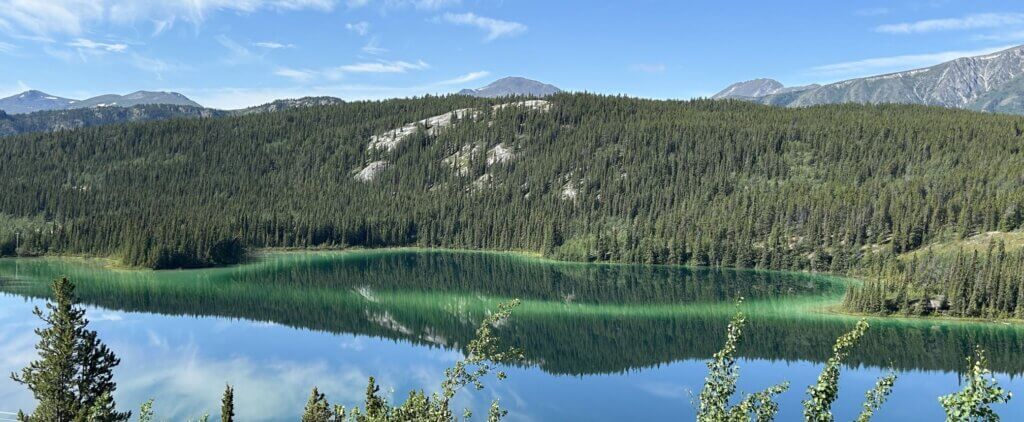
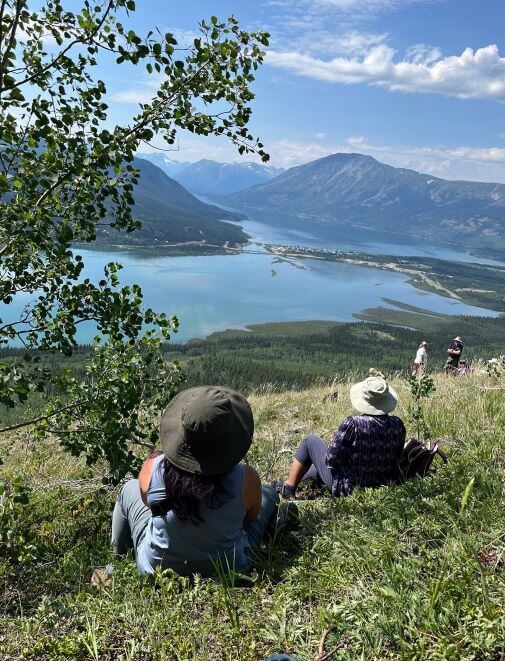
Unfortunately the next day rain was in the forecast so we spent a pleasant morning at the Yukon Wildlife Preserve, walking about 5K and seeing many iconic species such as caribou and bison, not animals we see in the south. I even saw a Canada Lynx for the first time! The preserve has been around since the 1960’s to care for northern animals. It now serves as a rehab and research centre and offers educational programming for local schools and tourists. A very pleasant way to spend the morning. We also found out later that all the rain caused a landslide near the trail we had planned, and it would have kept us on the “other side” had we headed that way. Good call not to go!
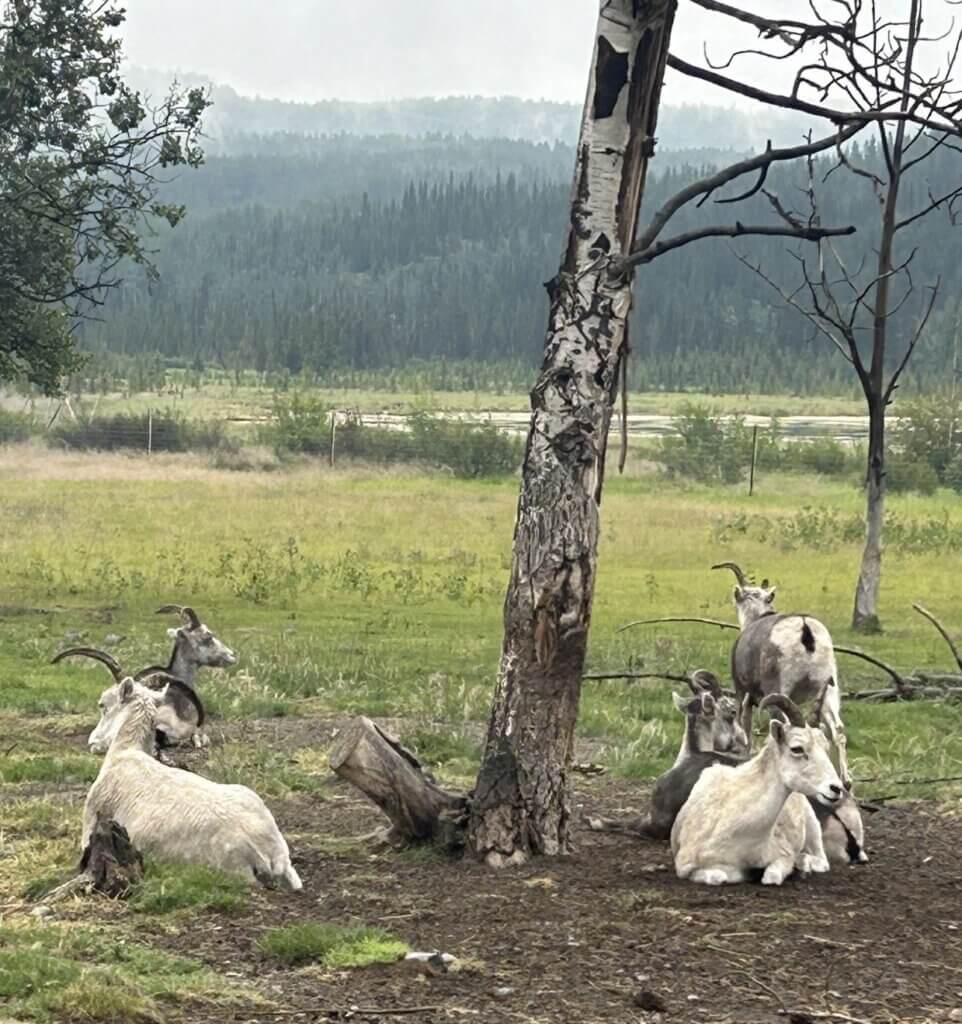
Dawson City
Day 5 – off to Dawson City – about 6 hours away by road. Fortunately, time for stopping at marvellous places such as the famous Braeburn Lodge (dinner plate size cinnamon buns!) and the 5 Finger Rapids. At this spot, 4 small islands divide the Yukon River into 5 channels, creating a dangerous passageway to the gold seekers who had already successfully crossed navigated the same treacherous river at Canyon City in Whitehorse. Today it has a viewing platform at the top so that everyone can have a fantastic view of area, and also and offers stairs down the steep slope so you can get even closer <more wow!>.
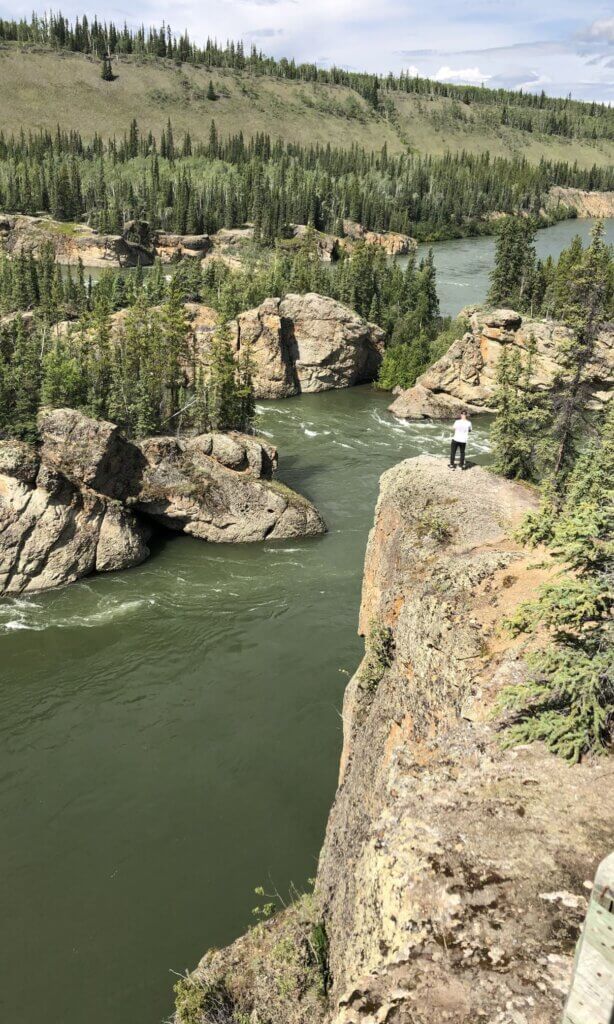
We arrived at Dawson city in time for dinner and followed that with a visit to the famous Diamond Tooth Gerties, Canada’s oldest casino, where we were entertained by a Klondike-era cancan show. At the height of the goldrush in 1897-1898, Dawson had more than 16,000 people, a few years later it was down to 5,000. Today, less than 2,000. Dawson is a fascinating place to visit, with so much historical significance packed into such a short time frame.
We were able to visit the spectacular Tombstone Territorial Park for some hiking, enabling everyone to experience the infamous Dempster Highway. To me, Tombstone, also known as “Patagonia of the North”, is what the world would have looked like at the beginning of time – all you see is unending wilderness. No stores, no roads, no houses. The Dempster Highway is a relatively short 740KM stretch of road – starting near Dawson City and ending near Inuvik. You travel through incredible scenery on traditional lands of the Gwich’in First Nations community, crossing the continental divide 3 times. It’s all gravel, so you can’t go faster than about 50K/hour or your tires will be shredded. And, you keep your fingers crossed that you don’t get a flat, as the only place to get it fixed is in Eagle Plains (population 8) near the end, about an hour from the Arctic Circle.
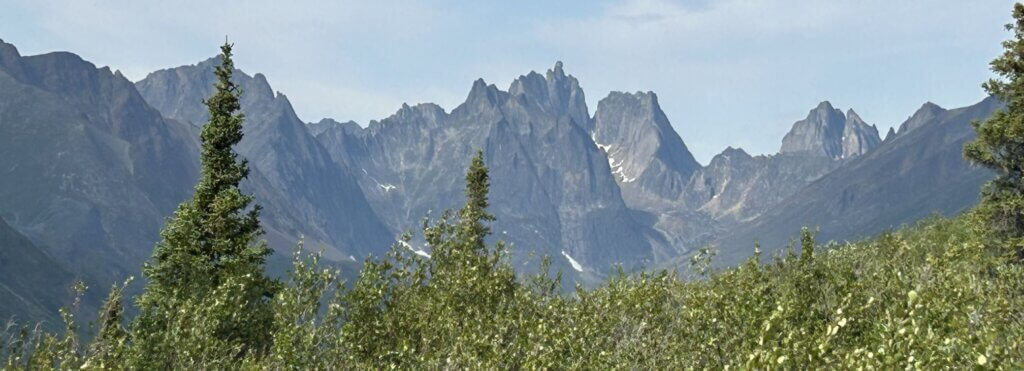
Haines Junction and Kluane National Park
Back to Whitehorse and then our next and final destination, Kluane National Park and Reserve, about 2 hours to the west. Many people camp in the park, we stayed in an inn at Haines Junction (population 1,018). What a backyard those people have! Kluane, part of a UNESCO World Heritage site, is home to Canada’s highest peak, Mount Logan. A vast wilderness known for its stunning landscapes and diverse ecosystems, it also includes the largest non-polar ice fields in the world. I learned that Kluane was 83% glaciers, which are, sadly, melting. There are numerous hiking trails, breathtaking views of glaciers, and pristine lakes. Wow! We did a variety of hikes in Kluane – some really easy and others a bit more challenging.
A stop at the Dai Ku Culture Centre was so educational. We learned about some Indigenous stories such as the one about the Rock People, and saw a healing canoe. This ocean-going dugout canoe started as a 450 year old, 6300 KG western red cedar, and took several years before it was completed in 2022. Creating this canoe was a physical, spiritual and emotional journey for all those involved, and is now used as a ceremonial boat.
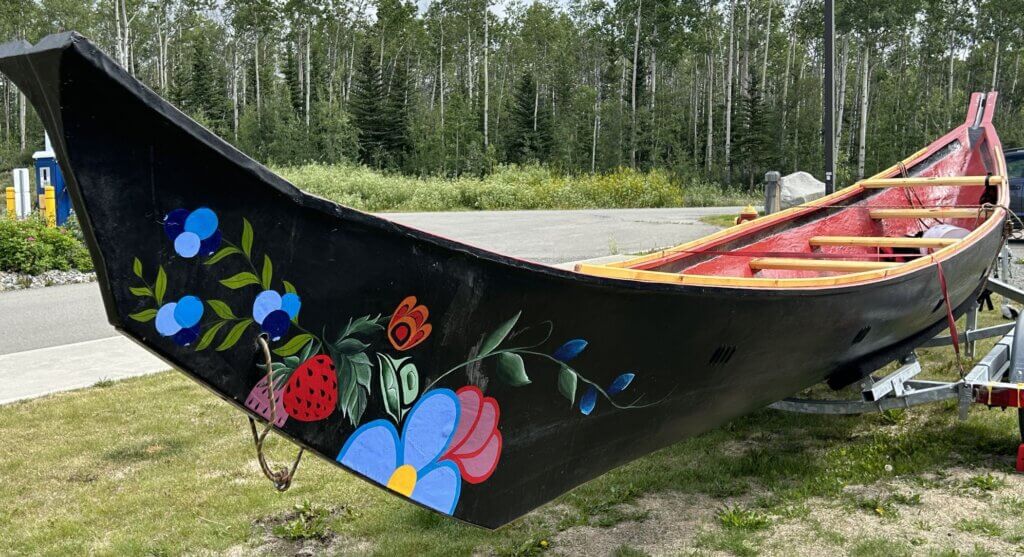
On our way back to Whitehorse, we visited the Long Ago Peoples Place, to learn about the traditional Southern Tutchone First Nations culture, structures and tools. The snares made from eagle feathers were ingenious, as was the “dead fall trap” for larger animals such as wolverines. Our hosts were very welcoming and shared so much information about their culture and heritage. I felt so fortunate to have been able to visit. They fed us a traditional meal of stew and bannock, thus capping our journey with a memorable and authentic experience, leaving everyone to think about the importance of reconciliation with our First Nations.
Where else can my feet take me?
3 highlights:
- Having the good fortune to be in Dawson City the weekend of the annual Moosehide Gathering, an inclusive event that celebrates the Tr’ondëk Hwëch’inand other Indigenous cultures, where we enjoyed some traditional music and unfortunately missed the Feast.
- Hiking some new trails, such as Nares Mountain, Cottonwood Trail, and Rock Glacier.
- Visiting places not accessible to me during COVID, such as the fish ladder in Whitehorse, The Campbell Region Interpretive Centre near Faro, and the Long Ago Peoples Place.
3 things for the next time:
- More time in Kluane – there are so many hikes in this beautiful area.
- An extra day or 2 in Dawson City, a small but fascinating place with such historical significance. It would be wonderful to explore more of the area including the gold mines, and hike more of Tombstone
- Ride the White Pass and Yukon train to the Laughton Glacier – an important component of the Klondike history. Unfortunately, it was closed due to bear activity the day we were scheduled to go.
Please contact me if you are interested in discovering wonderful places with a new travel community!
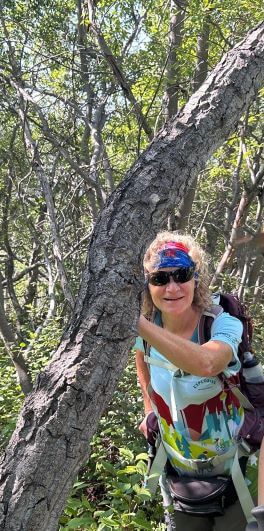
Recent Posts
Cycling Thailand
Cycling in Vietnam
Cycling in Holland
All Categories
Tags
Yukon Hiking 2024
I had the good fortune to return to Yukon to hike this year. I lived in Whitehorse for a year in 2020 and I was very excited to return to the land of the midnight sun to hike some of my favourite trails and try some new ones as well. I was travelling with one of my hiking clubs, 18 other keen hikers eager to experience the majestic beauty of the north.
Whitehorse
Our first morning included a tour of Whitehorse by bus, which served as a good reminder to me about where things were in the city and introduced me to some new things as well. We went to the fish ladder and learned that it is the longest wooden fish ladder in the world and plays a critical role in helping the salmon pass safely around the Whitehorse Rapids dam. We were too early in the season to see any fish passing through but the staff at the information centre were very knowledgeable and shared lots of information. This was closed in 2020 due to COVID so I am so glad I was able to stop in this time.
Back in the bus, we made our way to the SS Klondike sternwheeler (under restoration – no boat access), but stopped at the visitor welcome centre which was worth the time. We continued to Miles Canyon, one of my favourite places in Whitehorse. I was again astounded by its incredible beauty. We visited Canyon City, which I hadn’t done before, and learned of its importance during the gold rush days. We examined some of the remaining artifacts of the time and marvelled at the ability of people to quickly build a city with a dedicated tramway to address an acute need to support the stampeders (1897), a city which was pretty much deserted 10 years later.

In the afternoon, we headed to Fish Lake for our first Yukon hike. Rated as “easy” by Yukonhiking.ca (the go-to resource for Yukon trails), it is still a 7KM hike with 323M of elevation gain, about 200M more than what we experience in Southern Ontario. A wonderful hike, with incredible views that seem to go on forever once you reach the top. There are mountains and lakes that you can’t see from the trail head. You just don’t want to stop exploring! A really good introductory hike, and a bit of an eye-opener to what is considered “easy” by Yukon standards. Key learning for the day – the “very difficult” trails will be well beyond our ability on this trip.

Carcross
The next day we headed to Carcross, about an hour from Whitehorse, stopping at the magnificent Emerald Lake <wow!> for some photos. We started to hike Nares Mountain, graduating to “moderate” by Yukon standards. Like the prior day, fairly short in terms of distance (8K), but a challenging 1,000+ M in elevation gain.


Unfortunately the next day rain was in the forecast so we spent a pleasant morning at the Yukon Wildlife Preserve, walking about 5K and seeing many iconic species such as caribou and bison, not animals we see in the south. I even saw a Canada Lynx for the first time! The preserve has been around since the 1960’s to care for northern animals. It now serves as a rehab and research centre and offers educational programming for local schools and tourists. A very pleasant way to spend the morning. We also found out later that all the rain caused a landslide near the trail we had planned, and it would have kept us on the “other side” had we headed that way. Good call not to go!

Dawson City
Day 5 – off to Dawson City – about 6 hours away by road. Fortunately, time for stopping at marvellous places such as the famous Braeburn Lodge (dinner plate size cinnamon buns!) and the 5 Finger Rapids. At this spot, 4 small islands divide the Yukon River into 5 channels, creating a dangerous passageway to the gold seekers who had already successfully crossed navigated the same treacherous river at Canyon City in Whitehorse. Today it has a viewing platform at the top so that everyone can have a fantastic view of area, and also and offers stairs down the steep slope so you can get even closer <more wow!>.

We arrived at Dawson city in time for dinner and followed that with a visit to the famous Diamond Tooth Gerties, Canada’s oldest casino, where we were entertained by a Klondike-era cancan show. At the height of the goldrush in 1897-1898, Dawson had more than 16,000 people, a few years later it was down to 5,000. Today, less than 2,000. Dawson is a fascinating place to visit, with so much historical significance packed into such a short time frame.
We were able to visit the spectacular Tombstone Territorial Park for some hiking, enabling everyone to experience the infamous Dempster Highway. To me, Tombstone, also known as “Patagonia of the North”, is what the world would have looked like at the beginning of time – all you see is unending wilderness. No stores, no roads, no houses. The Dempster Highway is a relatively short 740KM stretch of road – starting near Dawson City and ending near Inuvik. You travel through incredible scenery on traditional lands of the Gwich’in First Nations community, crossing the continental divide 3 times. It’s all gravel, so you can’t go faster than about 50K/hour or your tires will be shredded. And, you keep your fingers crossed that you don’t get a flat, as the only place to get it fixed is in Eagle Plains (population 8) near the end, about an hour from the Arctic Circle.

Haines Junction and Kluane National Park
Back to Whitehorse and then our next and final destination, Kluane National Park and Reserve, about 2 hours to the west. Many people camp in the park, we stayed in an inn at Haines Junction (population 1,018). What a backyard those people have! Kluane, part of a UNESCO World Heritage site, is home to Canada’s highest peak, Mount Logan. A vast wilderness known for its stunning landscapes and diverse ecosystems, it also includes the largest non-polar ice fields in the world. I learned that Kluane was 83% glaciers, which are, sadly, melting. There are numerous hiking trails, breathtaking views of glaciers, and pristine lakes. Wow! We did a variety of hikes in Kluane – some really easy and others a bit more challenging.
A stop at the Dai Ku Culture Centre was so educational. We learned about some Indigenous stories such as the one about the Rock People, and saw a healing canoe. This ocean-going dugout canoe started as a 450 year old, 6300 KG western red cedar, and took several years before it was completed in 2022. Creating this canoe was a physical, spiritual and emotional journey for all those involved, and is now used as a ceremonial boat.

On our way back to Whitehorse, we visited the Long Ago Peoples Place, to learn about the traditional Southern Tutchone First Nations culture, structures and tools. The snares made from eagle feathers were ingenious, as was the “dead fall trap” for larger animals such as wolverines. Our hosts were very welcoming and shared so much information about their culture and heritage. I felt so fortunate to have been able to visit. They fed us a traditional meal of stew and bannock, thus capping our journey with a memorable and authentic experience, leaving everyone to think about the importance of reconciliation with our First Nations.
Where else can my feet take me?
3 highlights:
- Having the good fortune to be in Dawson City the weekend of the annual Moosehide Gathering, an inclusive event that celebrates the Tr’ondëk Hwëch’inand other Indigenous cultures, where we enjoyed some traditional music and unfortunately missed the Feast.
- Hiking some new trails, such as Nares Mountain, Cottonwood Trail, and Rock Glacier.
- Visiting places not accessible to me during COVID, such as the fish ladder in Whitehorse, The Campbell Region Interpretive Centre near Faro, and the Long Ago Peoples Place.
3 things for the next time:
- More time in Kluane – there are so many hikes in this beautiful area.
- An extra day or 2 in Dawson City, a small but fascinating place with such historical significance. It would be wonderful to explore more of the area including the gold mines, and hike more of Tombstone
- Ride the White Pass and Yukon train to the Laughton Glacier – an important component of the Klondike history. Unfortunately, it was closed due to bear activity the day we were scheduled to go.
Please contact me if you are interested in discovering wonderful places with a new travel community!

